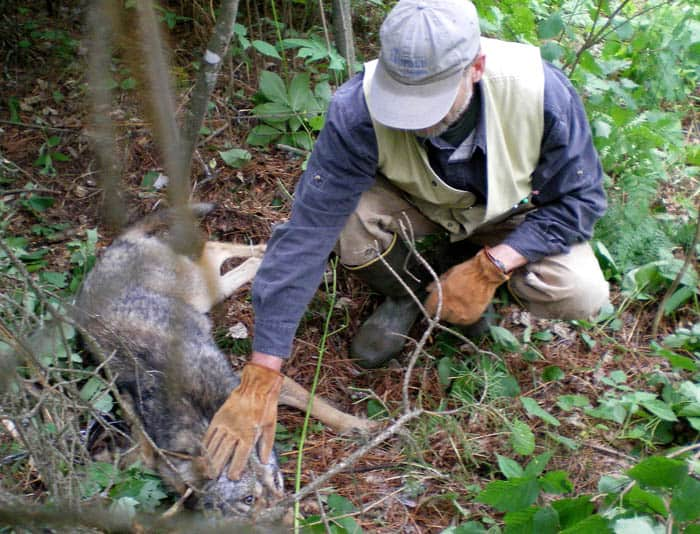Wolves Cause Some Scientists to Lose Objectivity
Patrick Durkin 11.01.13

As Wisconsin’s second wolf season got underway October 15, we heard claims that the state’s Department of Natural Resources (DNR) was ignoring science and risking a destabilized wolf population by setting a 251-wolf kill quota for the 2013 hunting and trapping season.
And those who attended The Wildlife Society’s annual national conference in Milwaukee on October 7-8 heard University of Wisconsin-Madison professor Adrian Treves claim wolf poaching is rising. During the conference, Treves also said the Wisconsin DNR’s 2013 wolf quota is “not sustainable nor responsible.”
Such claims pack punch because we like to think university researchers are detached, objective folks who disdain emotion, shun advocacy, and avoid predictions they can’t support with data.
In other words, we expect learned professors to stay above the frays of us caterwauling commoners. But maybe that’s asking too much of mere mortals who deal with wolves. Until the early 1990s, for example, Wisconsin DNR researchers named each wolf wearing a radio-transmitting collar. Instead of scientific IDs like “XT1F34” or “DNR9999,” we had Candys, Randys, and Mandys roaming the Northwoods. The agency pros stopped the practice after realizing it hurt their scientific credibility.
To be fair, naming wolves isn’t unique to the Wisconsin DNR. For example, researchers studying the famous wolves of Isle Royale in Lake Superior named wolves they radio-collared, too. Meanwhile, when fitting Isle Royale’s moose with radio-collars, they weren’t so sentimental. They stuck with standard scientific IDs.
Professor Treves has been especially vocal in opposing Wisconsin’s wolf hunt the past two years. When testifying in July 2012 to the Wisconsin Natural Resources Board, Treves warned that the 2012 quota of 116 wolves risked an “unsustainable harvest.” He also said: “Wisconsin is likely to equal or exceed the (quota) and drive our wolf population below 350 the first year (2012).”
Treves’ prediction that hunters and trappers would exceed the quota in 2012 was correct, technically. Instead of killing 116, they killed 117 before the DNR closed the season. Even so, this year’s census found the 2012 hunt had virtually no impact on Wisconsin’s estimated 810-wolf population.
Granted, Wisconsin’s 251-wolf quota for 2013 cannot be sustained indefinitely, but the WDNR never said it was an annual harvest goal. The kill-quota will vary annually as agency biologists assess the wolf population and adjust accordingly. To suggest otherwise is misleading.
Even so, Treves is making similar dire predictions about this year’s quota. He told the Milwaukee Journal-Sentinel in mid-October: “It could drive the wolf population back to threatened status and close the hunting season after just a couple of years.”
The DNR, meanwhile, predicts this year’s quota will cause a net reduction of 13 percent, which would leave roughly 700 wolves next year.
We should also note that Wisconsin’s 350-wolf population goal isn’t the historical relic some imply. The DNR’s Wolf Science Advisory Committee affirmed it in 2007 after reviewing the agency’s 1999 wolf management plan. The 2006-07 DNR wolf committee was staffed by credentialed experts from the state agency and the University of Wisconsin. Further, wolf numbers were estimated at 560 in 2007, or about 150 fewer than current estimates.
Treves has also been a frequent critic of wolf hunting methods allowed during Wisconsin’s wolf season. In his 2012 testimony to the DNR Board, he said: “There is no peer-reviewed scientific evidence to support the safety or efficacy of hunting wolves with hounds […] [nor is there] scientific evidence to support the safety or efficacy of hunting wolves with bait.”
Both statements are true, but we can’t expect peer-reviewed scientific studies when regulated wolf hunts didn’t exist until 2009 in the United States, and only Wisconsin offers hunting with trailing hounds. Further, if peer-reviewed research of wolf-baiting and wolf-hounding is a worthy goal, how can we get any scientific data if we don’t offer any opportunities to test the effectiveness of different hunting methods?
Treves’ claim about a recent rise in wolf poaching is also puzzling. DNR records show the agency investigated 1,007 dead wolves from 1979 through 2012, and declared 205 (20 percent) to be illegal kills. But from 2003 through 2012 the illegal kill rate was 19 percent, and after hitting a 10-year high of 30 percent in 2011 it fell to 17 percent in 2012—the hunt’s first year.
In fact, a DNR survey of 2012’s wolf hunters found most of them demonstrated respect toward wolves. When asked if they shot at the first wolf that presented an opportunity, 66.5 percent said no. Their number-one reason? They were waiting for a better shot.
Further, of those who killed a wolf, 60 percent took its hide to a taxidermist for mounting, and 33 percent tanned and kept it. Why would so many wolf hunters pass up iffy shots, and 93 percent preserve their kill for display, if they hate the sight of wolves?
Granted, Wisconsin is only one year into state-regulated wolf hunts, so it’s too soon to draw lasting judgments. But isn’t that the point? We should be studying these hunts to learn more about wolves, wolf management, and those who hunt or trap them.
Perhaps everyone involved should quit accusing others of ignoring science and research unless they’re practicing both themselves.

